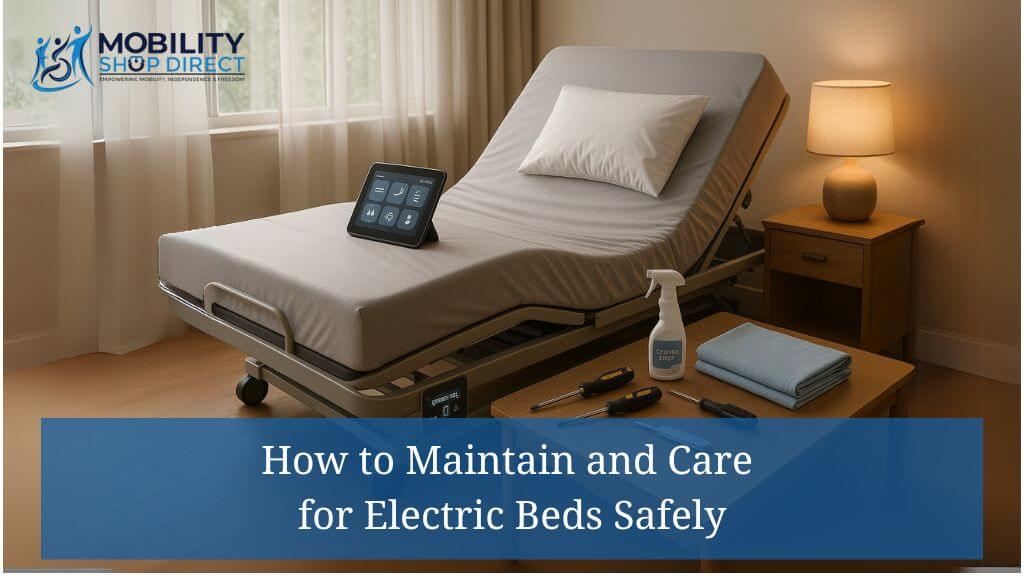An electric bed is far more than a basic piece of furniture: it’s a blend of technology and comfort designed to enhance daily living. Whether used at home, in a healthcare facility, or for specialized needs, an electric bed delivers convenience, safety, and adaptability. However, as with any advanced mechanism, diligent maintenance is critical to keep it functioning reliably. Without regular care, even minor issues can develop into safety risks, costly repairs, or operational failures at the most inopportune moments.
This comprehensive guide will empower you with practical, easy-to-follow steps to keep your electric bed operating smoothly and safely for years to come. We'll cover everything from setting up an effective servicing routine to safeguarding electrical components and responding to spills. With this knowledge, you’ll be fully equipped to protect your investment while ensuring optimal comfort and usability.
Ready to prioritize your electric bed’s maintenance? Let’s dive in.
Table of Contents
- Why Is Electric Bed Maintenance Important?
- How Often Should Electric Beds Be Serviced?
- Managing Spills and Protecting Bed Electronics
- Inspecting Electrical Components for Safety
- Conclusion
Key Takeaways
Maintaining your electric bed ensures it remains safe, reliable, and efficient. Here are the most important practices to keep in mind:
- Follow a Regular Maintenance Schedule: Inspect and service your electric bed every 6–12 months to catch and address wear and tear before it escalates.
- Act Quickly on Liquid Spills: Immediately clean up spills to protect motors, electronics, and mechanisms from potential damage.
- Inspect Electrical Components Frequently: Regularly check for frayed cords, loose fittings, and signs of power irregularities to prevent hazards.
- Monitor Mechanical Parts: Tighten loose bolts, listen for unusual noises during adjustments, and align all moving components to promote smooth operation.
- Prioritize Cleaning and Sanitization: Safeguard hygiene with gentle cleaning agents designed for compatibility with both surfaces and sensitive parts.
By incorporating these proactive actions, you’ll safeguard the longevity, performance, and safety of your electric bed while enjoying unparalleled comfort.
Why Is Electric Bed Maintenance Important?
The Role of Proper Maintenance in Safety and Longevity
Good maintenance serves as both a safeguard and an investment in long-term usability. An electric bed in optimal condition lowers the likelihood of sudden malfunctions that can compromise safety, such as mechanical failures or electrical hazards. For example, regular lubrication of moving parts ensures smooth operations, while tight connections prevent instability.
Additionally, correct maintenance extends the lifespan of components prone to wear, such as motors, hinges, or electrical wiring. Addressing minor issues such as slight misalignments or loose connections before they worsen can save significant costs tied to major repairs or replacements.
Furthermore, a consistently reliable bed provides more than just operational peace of mind—it enhances quality of life. Whether for leisure or medical purposes, knowing that your electric bed is in perfect working order allows you to focus on relaxation or care, free of disruptions.
Consequences of Neglecting Electric Bed Care
Failing to maintain an electric bed introduces risks that extend beyond inconvenience. Dust, debris, and spills, when left unaddressed, can infiltrate sensitive areas like the motor or control panel, leading to gradual deterioration or outright breakdowns. For example, unaddressed moisture damage can corrode circuits or trigger dangerous short circuits.
Mechanical neglect, such as loose bolts, misaligned frames, or unverified safety locks, can compromise stability, potentially causing discomfort or injury. Additionally, consistent malfunctions such as uneven adjustments or stalling motors may leave optimal use compromised, negating the bed’s intended purpose altogether.
The costs associated with neglect; whether due to repairs, replacements, or reduced safety - often far exceed the time and effort required for routine inspections and maintenance. Learn more about these potential pitfalls in our post on using electric beds safely at home.
How Often Should Electric Beds Be Serviced?
Creating an Electric Bed Maintenance Schedule
Following a structured maintenance schedule is the cornerstone of effective care. Perform a basic inspection every 6 months to examine vital components: check for structural integrity, electrical safety, and smooth operation. Annually, consider hiring a professional for a comprehensive tune-up to evaluate intricate parts like motors, control panels, and electrical connections.
Specific recommendations may vary based on frequency of use, environmental factors, and model-specific guidelines provided by manufacturers.
Signs That Indicate More Frequent Servicing Is Needed
Even with a consistent schedule, some red flags indicate a need for faster action:
- Slower or jerky bed adjustments.
- Grinding, clicking, or buzzing sounds from the motor or mechanics.
- Physical damage to cords, plugs, or connectors.
- Overheating or a persistent burning smell during use.
Managing Spills and Protecting Bed Electronics
What To Do If a Liquid Spill Occurs on an Electric Bed
When a spill happens, your top priority is to disconnect the electric bed from any power source to ensure safety. After unplugging, carefully dab the spill with a clean, dry cloth to absorb as much liquid as possible. Avoid trying to operate the bed until you’re sure all components are completely dry and undamaged. If the spill reached sensitive electrical areas, involve a professional to rule out hidden issues.
Preventive Measures to Avoid Spills
Minimize spill risks by using protective covers like waterproof mattress pads. Position beverages or liquids far from control panels and moveable parts, especially in healthcare or domestic settings where spills are more likely due to mobility or health-related needs.
How Spills Impact Electrical Components and Mechanisms
Liquids, when seeping into circuits or mechanical components, can corrode metal or cause electrical malfunctions. Even seemingly harmless spills can shorten lifespan, causing irreversible damage to critical parts or creating fire hazards.
Inspecting Electrical Components for Safety
How to Identify Wear and Tear on Cords, Plugs, and Connectors
Inspect cables for fraying, cracks, pinched sections, or loose wires. Carefully examine connectors for discoloration, burn marks, or bent pins, replacing damaged components immediately to maintain safety and operability.
Recognizing Signs of Unsafe Electrical Connections
Look closely for warning signs like overheating, flickering or intermittent adjustments, sparks, or unusual odors. These indicate underlying electrical faults that could compromise functionality or safety.
When to Call for Professional Electrical Repair
Issues such as persistent power interruptions, internal wiring complications, or unexplained system errors often require an expert touch. Professionals possess the tools and experience to repair or replace components properly, avoiding costly mistakes or prolonged downtime.
Conclusion
Proper maintenance of an electric bed is not merely optional - it’s essential for safety, comfort, and durability. Preventive care shields both the users and the mechanism itself from avoidable risks while maintaining peak functionality. By adopting a proactive approach that includes regular inspections, timely repairs, spill management, and cleaning routines, you’ll protect your investment and enjoy the enhanced quality of life it brings.
Don’t wait - start implementing these simple yet effective practices today. A few minutes of care now can save you significant time, money, and hassle in the future. By prioritizing maintenance, you’re not only preserving the comfort and convenience your electric bed provides; you’re actively investing in long-term peace of mind.



